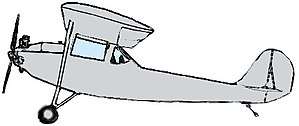Rearwin Junior
| Rearwin Junior | |
|---|---|
 | |
| Rearwin Junior sideview | |
| Role | Sport aircraft |
| National origin | United States |
| Manufacturer | Rearwin |
| Designer | Douglas Webber |
| First flight | 1931 |
| Number built | ca 30 |
The Rearwin Junior was a sport aircraft produced in the United States by Rearwin Airplanes Inc..[1] The aircraft was based on the earlier American Eagle Eaglet two-seat tandem ultra-light high-winged monoplane of the early 1930s.[2] Intended as a low-cost aircraft, the limited production run of the Rearwin Junior relegated it to a footnote in aviation history.[3]
Design and development
The Rearwin Junior was designed in 1931 by a former American Eagle employee Doug Webber with assistance from welder Noel Hokaday. The aircraft was based on the earlier American Eagle Eaglet two-seat tandem ultra-light high-winged monoplane. The Rearwin Junior went into a limited production in 1931.[4]
The design was a conventional, high-wing monoplane with two seats in tandem in an open cockpit and fixed, tailskid undercarriage.[3] An optional enclosed canopy was also available.[5] The wings were of wooden construction while the fuselage and empennage were built from welded steel tube, with the whole aircraft skinned in fabric.[5]
Operational history
Although the Rearwin Junior was designed to meet the lowest possible sale price, the onset of the Great Depression severely limited the size of the market for sport aircraft, and only a small number were built.[3]
Variants
- Junior 3000 - version with Szekely SR-3 engine (approximately 20 built)
- Junior 3001 - version with Poyer engine (one built, later converted to the Junior 4000 standard)
- Junior 3100 - version with Szekely SR-5 engine (Two built)
- Junior 4000 - version with Aeromarine AR-3 engine (eight built)
Specifications (3000)
Data from "Rearwin Junior"
General characteristics
- Crew: One pilot
- Capacity: 1 passenger
- Length: 21 ft 11 in (6.68 m)
- Wingspan: 36 ft 0 in (10.97 m)
- Height: 7 ft 6 in (2.29 m)
- Wing area: 180 ft2 (16.7 m2)
- Empty weight: 570 lb (260 kg)
- Gross weight: 1,000 lb (450 kg)
- Powerplant: 1 × Szekely SR-3, 45 hp (30 kW)
Performance
References
Notes
Bibliography
- The Illustrated Encyclopedia of Aircraft. London: Orbis: Aerospace Publishing, 1985. ASIN: B00OKTF7UA.
- Simpson, Rod. Airlife's World Aircraft. Ramsbury, UK: Airlife Publishing Ltd., 2001. ISBN 1-84037-115-3.
- Taylor, Michael J. H. Jane's Encyclopedia of Aviation. London: Studio Editions, 1989. ISBN 978-1-8517-0324-1.
- Underwood, John W. "The reluctant Eagle of skid row." Air Progress, June 1968, pp. 46–47, 62–63.